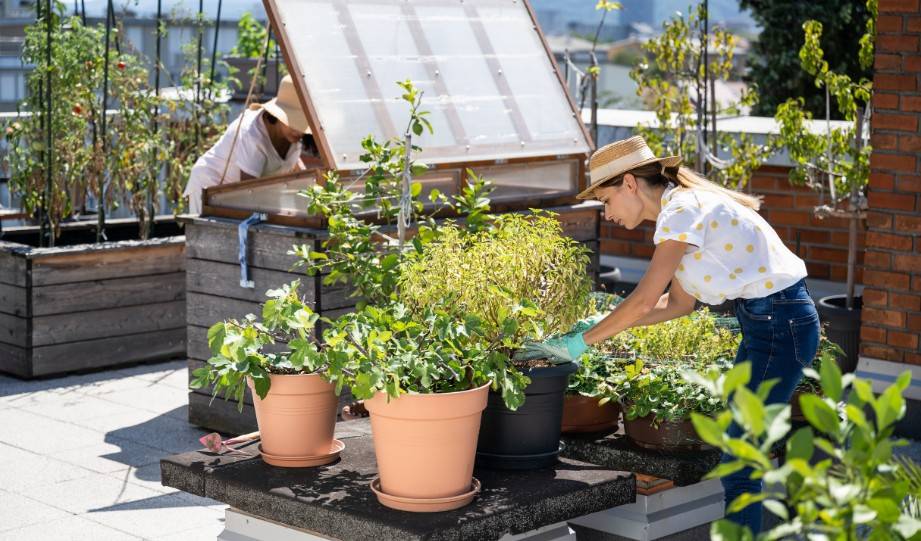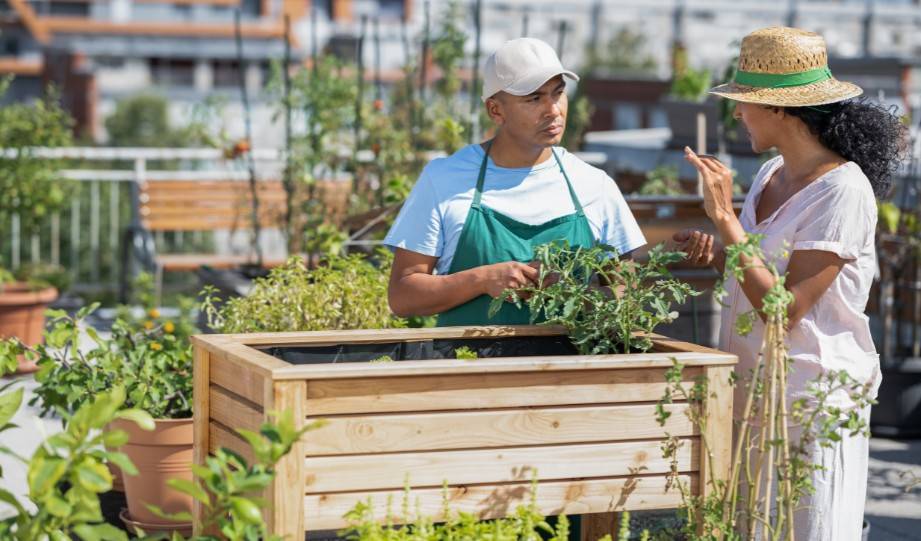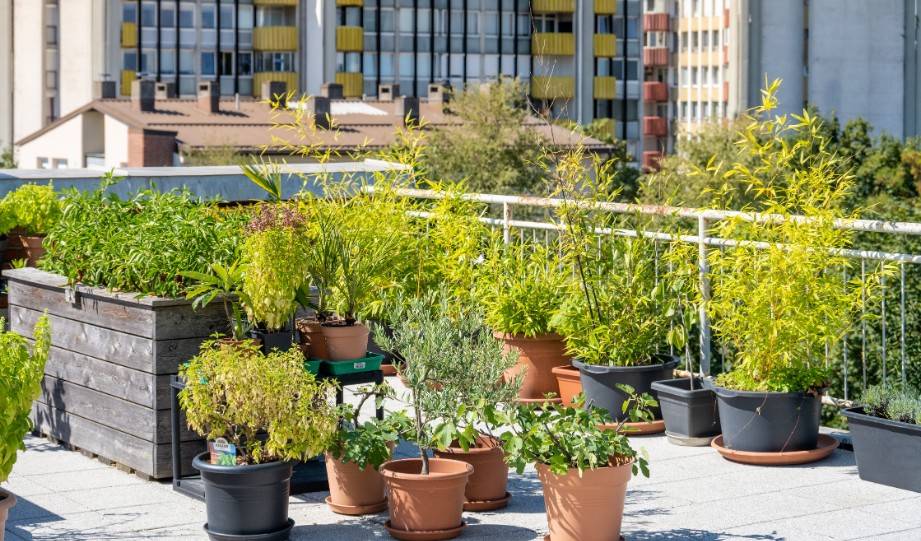Rooftop gardens are transformative, turning unused urban spaces into vibrant, green sanctuaries. In cities where ground space is scarce, utilizing rooftops for gardening not only maximizes available areas but also introduces a slice of nature into the concrete jungle.
Beyond the practical use of space, rooftop gardens offer substantial environmental benefits.
They reduce the urban heat island effect, improve air quality, and provide habitats for city-dwelling wildlife.
Moreover, the act of growing your own food delivers unparalleled satisfaction. It’s about creating life and sustenance in the unlikeliest of places – above the hustle and bustle of city streets.
Understanding the Basics of Rooftop Gardening

Evaluating Your Space
Before embarking on your rooftop garden journey, assessing your space is essential.
Firstly, recognize that not all rooftops are designed to bear the weight of a garden. This includes the soil, plants, containers, and even water.
It’s vital to understand the structural capacity of your rooftop. This ensures the safety of your garden project.
Consulting a structural engineer can provide a clear picture of how much weight your rooftop can handle.
This step is the cornerstone of creating a safe and sustainable rooftop garden, paving the way for your urban gardening adventure.
Legal and Safety Considerations
Before your garden can bloom, navigating the legal landscape is a must.
Securing permissions is your first step. Many urban areas have specific building codes and regulations regarding rooftop usage.
It’s crucial to ensure your garden plan complies with these requirements to avoid legal issues down the line.
Additionally, prioritize safety measures. This includes creating secure access to your rooftop and ensuring that any structures or containers are safely installed.
Taking these steps not only ensures your garden is legal but also safe for everyone involved, laying a solid foundation for your rooftop gardening project.
Choosing the Right Plants
Selecting the right plants for your rooftop garden hinges on three key factors: climate zone, sunlight exposure, and personal preferences.
Firstly, know your climate zone. This knowledge guides you in choosing plants that will thrive in your urban environment.
Next, consider the sunlight your rooftop receives. Full sun, partial shade, or full shade? Your observation dictates the type of plants that can grow well in your space.
Lastly, factor in what you love. Whether it’s colorful flowers, lush foliage, or fresh produce, your preferences should guide your final selections, ensuring your rooftop garden is both a personal and environmental haven.
Getting Started with Your Rooftop Garden

Essential Supplies and Tools
Kicking off your rooftop garden requires gathering some key supplies and tools.
Firstly, quality soil is fundamental. Opt for a mix designed for container gardening, ensuring good drainage and nutrient retention.
Next, choose containers that fit your space and the plants you aim to grow. Consider lightweight materials and ensure they have proper drainage holes.
A reliable watering system is also crucial. Whether it’s a simple watering can or a more sophisticated drip irrigation system, consistent hydration is key to your garden’s success.
Lastly, don’t forget basic gardening tools like trowels, pruning shears, and gloves. These essentials will make planting and maintenance much smoother.
Setting Up Your Space
Organizing your rooftop space efficiently is vital for the success of your garden.
Start by considering weight distribution. It’s crucial to spread out heavier items, like large containers and soil bags, to avoid putting too much pressure on any one area of the roof.
Access to water is another key consideration. Position your plants so that watering them is convenient, possibly near a water source or in a layout that makes it easy to use a hose or watering can without obstacles.
Sun exposure should guide the placement of your containers. Group plants with similar sunlight needs together.
Full-sun plants should be placed in the brightest spots, while shade-loving varieties can be positioned in less exposed areas.
By thoughtfully planning the layout of your rooftop garden, you ensure not only the health and productivity of your plants but also the safety and sustainability of your gardening practice.
Planting Your Garden
Once your space is set up, it’s time to plant your garden.
Begin with soil preparation. Fill your containers with the potting mix, leaving some space at the top for watering.
For seeds, make small indentations in the soil according to the depth specified on the seed packet.
For seedlings, dig a hole big enough to accommodate the root ball.
Spacing is crucial. Plants need room to grow and access to sunlight, so refer to the guidelines for specific plants.
Overcrowding can lead to competition for light, water, and nutrients.
Water your plants gently after planting. This helps settle the soil around the roots and hydrates your new plants.
Remember, the early days are critical for establishing your garden. Regularly check your plants for moisture and adjust your watering schedule based on the weather and the plants’ needs.
This initial care sets the foundation for a thriving rooftop garden.
Maintaining Your Rooftop Garden

Watering and Feeding
Keeping your rooftop garden thriving involves a balanced approach to watering and feeding.
For watering, consider the specific needs of your plants. Some may require daily watering, especially in hot weather, while others might need less frequent hydration.
Implementing a drip irrigation system can ensure a consistent water supply without overdoing it.
Fertilizing is equally important. Use a balanced, all-purpose fertilizer to nourish your plants according to the package instructions.
Typically, a monthly feeding during the growing season suffices, but adjust based on plant response and growth.
This regimen of careful watering and regular feeding will support the health and vigor of your rooftop garden, ensuring a lush, productive space.
Pest Management and Disease Control
In rooftop gardening, vigilance is key to managing pests and diseases.
Start by regularly inspecting your plants for signs of trouble, such as unusual spots, wilting, or pest activity. Early detection can make all the difference.
For pests, consider environmentally friendly options first, such as insecticidal soaps or natural predators like ladybugs.
For diseases, proper spacing and airflow around plants can prevent many issues. If you do spot a problem, remove affected parts or use appropriate fungicides, following organic practices whenever possible.
Remember, a healthy garden is less susceptible to pests and diseases, so focus on providing optimal growing conditions.
Seasonal Care and Harvesting
Adapting your care routine with the seasons ensures your rooftop garden remains vibrant year-round.
In spring, prepare your garden for new plantings by refreshing the soil and cleaning out containers.
Summer demands diligent watering and pest management.
Come fall, consider adding organic mulch to protect plants from cooler temperatures.
Winterize your garden by removing annuals and covering perennials with protective material.
Harvesting is most rewarding when done at peak ripeness. This varies among plants: tomatoes should be fully colored and slightly soft, greens crisp and bright, and herbs aromatic.
Timely harvesting encourages more produce and extends your garden’s bounty.
Overcoming Challenges

Dealing with Weather Extremes
Rooftop gardens are particularly exposed to the elements, making protection against weather extremes vital.
For high winds, secure larger plants and containers to railings or other sturdy structures. Use windbreaks or trellises to shield more delicate plants.
During intense heat, increase watering frequency and consider installing shade cloth to protect plants from scorching sun. Mulching can also help retain soil moisture and keep roots cool.
Preparation and adaptability are key. By anticipating and mitigating weather challenges, you can ensure your rooftop garden remains a thriving refuge no matter what the weather brings.
Space and Resource Limitations
Maximizing space and resources is a common challenge in rooftop gardening, but creative solutions can turn these limitations into advantages.
Vertical gardening techniques, such as trellises or wall planters, can dramatically increase your growing area without expanding your footprint.
For resources, consider installing a rainwater collection system to supplement your watering needs, reducing reliance on tap water.
Additionally, choose multi-purpose plants that provide both beauty and produce, like edible flowers or herbs that can also serve as pest deterrents.
These strategies allow you to make the most of your rooftop space, ensuring a productive and sustainable garden oasis.

Read More:
Conclusion
Rooftop gardening offers a unique blend of personal satisfaction and community enhancement.
By transforming underused urban spaces into vibrant green areas, you contribute to a healthier environment and gain a rewarding hobby. The patience and care invested in your garden not only yield fresh produce but also a sense of accomplishment.
I encourage you to embark on your own rooftop gardening journey. The benefits are profound and lasting.
Share your experiences and tips with the community. Together, we can cultivate a greener, more sustainable urban landscape.

